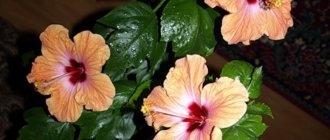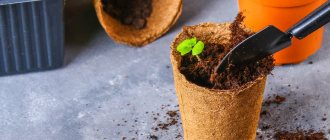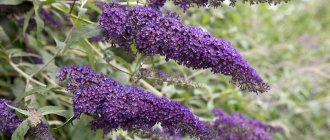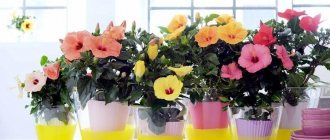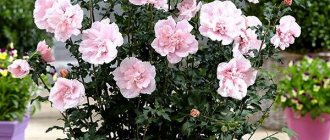Advantages and disadvantages of this method of reproduction
The heat-loving hibiscus, originally from the tropical forests of the Malay Archipelago, is valued for its highly decorative appearance of abundant bright green leaves and elegant simple or double large flowers, which are distinguished by a variety of rich colors.
When growing, the seed method is often practiced, which has the following advantages:
- simple execution technology;
- ability to check seed germination;
- lower possibility of transmission of viral infection compared to growing methods;
- a well-developed root system, allowing seedlings to more easily tolerate transplantation.
It is necessary to take into account the possible disadvantages of the seed method:
- high probability of acquiring low-quality seed or seed that does not meet certain characteristics;
- frequent discrepancy between the independent procurement of seeds of reproduced seedlings and the varietal qualities of the mother plant.
Description and characteristics of tree hibiscus
More than 200 varieties of hibiscus are known. In nature, they grow in countries with subtropical and tropical climates; many species are cultivated. The Syrian hibiscus (garden) variety is popular among flower growers. It is represented by tall deciduous shrubs.
Straight, even branches 3-6 m long are covered with oval, bright green leaves. They are hard, glossy, and shaped like oak leaves. The flowers are single, double or simple type with a diameter of up to 12 cm. The color of the petals is one-color or two-color. Different color shades:
- white;
- dark red;
- soft lilac;
- dark purple;
- pale and bright pink.
This type of shrub plant develops slowly. The rate of growth depends on the quality of care. Proper watering plays an important role. Blooms in the 3-4th year of life. The flowering period is long. It starts in July and ends closer to November.
The flower lives and pleases the eyes with its appearance for only 1 day. The buds open in the morning and close by the end of the day. This does not affect the degree of decorativeness of the tree-like shrub. There are many buds, they bloom every day, so the bush is strewn with large flowers every day.
The frost resistance of varieties with simple flowers is higher than that of double varieties of Syrian hibiscus. The latter need to be covered for the winter, and varieties with simple flowers easily tolerate light winters with short-term frosts of up to 5-10 ° C. Syrian hibiscus needs to be covered if winter temperatures stay around -15 °C for weeks.
How to select and collect seed material?
When purchasing hibiscus seeds in a specialized store, it is advisable to choose varietal varieties if you plan to independently prepare seed in the future. Check the date of collection, since germination begins to decline after packaging within a year.
F1 hybrids belonging to the first generation adapt faster to environmental conditions, but they cannot be expected to bear fruit. Self-collection should be carried out after the pods with seeds inside have fully matured.
Important! It is necessary to start cutting fruits in a timely manner, to know how ripe they look, since overripe pods open and the grains fall to the ground. The degree of ripeness is indicated by the brown tint of the peel.
After harvesting, the seeds are released and scattered on white thick paper. Discard small, dry, damaged grains. The remaining material is dried and then poured into paper bags.
Syrian hibiscus photo
This flower blooms almost all year round. It has evergreen leaves and flowers of different shades. It can be grown indoors or in the garden. One flower has a diameter of 7 to 12 centimeters. In appearance, Hibiscus flowers resemble mallows. The flower lives only one day.
Syrian Hibiscus can be of several varieties:
Hibiscus Totus Albus
It has snow-white flowers;
Hibiscus Monstrosus
Blooms white flowers all spring and autumn;
Hibiscus William R. Smith
This variety has white flowers with a red center;
Hibiscus Woodbridge
Blooms red with a ruby tint;
Hibiscus Blue Bird
It has blue or purple flowers. The flower may also be blue-violet;
Hibiscus Speciosus
It has double flowers, the shade of each flower is white, and its middle is dark red;
Hibiscus Jeanne d'Arc
Blooms with yellow-white flowers;
Hibiscus Due de Brabant
It has double flowers of a dark red color, they may have white stripes;
Hibiscus Ardens
It has pink and purple flowers.
When choosing a type of Syrian hibiscus, consider your region. Plants with double flowers love warm and mild climates. Such a flower cannot be placed on the balcony in early spring. He will die from low temperature.
What is needed for growing at home and in open ground?
To carry out the procedure for planting hibiscus seeds, you will need to first prepare a soil mixture and the necessary equipment. The main requirements for the soil of this tropical plant are high fertility, breathability, and light structure. When preparing it yourself, combine sand, garden soil, humus and ground high-moor peat in a ratio of 1:1:1::2.
You can purchase ready-made soil substrate. Among the extensive range there are options aimed at growing hibiscus directly with an optimally balanced composition.
Inventory list:
- containers for sowing - ceramic, plastic, wooden;
- a vessel equipped with a sprayer for water or a spray bottle;
- transparent film or glass;
- trowel;
- pots for transplanting seedlings after picking.
Diseases and pests
| Spider mite Ways to fight:
| |
| Chlorosis Ways to fight:
| |
| Ants Ways to fight:
|
Stratification
On the eve of planting, hibiscus seeds must undergo a stratification stage in order to intensify germination.
Step-by-step instruction:
- With vigorous stirring with a wooden spatula, dilute such a number of grains of potassium permanganate into 100 ml of slightly warmed water so that the liquid turns a faint pink color.
- The solution is filtered into a glass container through three layers of gauze.
- Pre-selected hibiscus seeds are soaked in it.
- After an hour, the grains are mixed in a plastic container with moistened sand and placed in the refrigerator. Maintain for 14 days.
After being removed from the cool, the seeds usually turn out to have hatched and are ready to move into the soil. If this does not happen, place the grains between damp layers of gauze for several days. As soon as the sprouts appear, planting work is carried out immediately.
Indoor hibiscus: propagation by cuttings
When pruning a green pet in the spring, lignified branches with buds are collected. If you place them in soil or in a glass of water, you can get beautiful seedlings.
- The branches are placed in a container with a nutrient solution of a growth stimulator poured into it for the formation of roots. Water is added periodically, as it evaporates quickly, and the roots take a long time to appear. When there are quite a lot of them on the cuttings, the seedlings are transferred to a pot with soil that is light and loose in structure. Usually the branches are cut off with leaves. They are not cut off, as they signal the condition of the cutting.
- With another planting method, the cuttings are immediately buried in the soil, leaving at least 2 buds above the surface. Future plants are covered with a glass jar or plastic bottle to prevent moisture evaporation and maintain the necessary microclimate. Under such conditions, it forms a full-fledged root system, which immediately connects with the ground, and the sprout begins to actively develop. It does not require time to survive after transplantation. A green leaf is a signal that the branch is developing well.
Cuttings are the best way to obtain new indoor hibiscus seedlings. It is never propagated by dividing the rhizome - a method acceptable for species growing in open ground: garden hibiscus, tree hibiscus.
How to plant?
Expanded clay is poured onto the bottom of the prepared container, the layer of which should occupy about 20 mm. Pour in the soil mixture, filling ¾ of the total volume of the container.
Then sowing is carried out, observing the following sequence:
- The soil is slightly moistened by irrigating with settled water using a spray bottle.
- Make grooves 10-15 mm deep at a distance of 55-60 mm from each other.
- The grains are placed in them, maintaining an interval of 20-25 mm.
- Cover the top with loose soil substrate without compacting it.
- Spray the crops with water again and cover the container with glass or cover it with film.
Install a miniature greenhouse in a room with an average temperature of 26-32 °C and good lighting.
How to care for a homemade Chinese rose
The plant loves a bright place, protected from direct sunlight. Hibiscus will not bloom in the shade. In the warm season, it feels great outdoors, so the bush can be placed on the balcony or in the garden. A place for this should be chosen that is protected from the scorching sun and drafts.
Air temperature and humidity
In summer, the hibiscus plant grows and blooms well at air temperatures from +18 to +25 degrees. In winter, the temperature should not be lower than +15 degrees, but home roses cannot tolerate heat either. At low temperatures, the plant may begin to shed its leaves.
You will be interested to know: 10 best blooming flowers for the home: photo, name, description
Chinese rose loves high air humidity. Therefore, during hot periods and in winter, when the heating is on, hibiscus leaves must be sprayed regularly. Once a month, and if possible more often, it is recommended to bathe the bush under a warm shower. During this procedure, dust and possible pests (for example, spider mites) will be washed off the leaves, and the plant itself will be saturated with a sufficient amount of moisture. A pot of soil should be wrapped in cellophane before bathing.
Watering and fertilizing
Hibiscus love abundant watering, especially during flowering and active growth. But they should be watered only after the top layer of soil has dried. Constant waterlogging of the soil can lead to the development of fungal diseases and root rotting. Insufficient watering, especially in hot weather, domestic Chinese roses do not tolerate well and begin to shed leaves and buds.
The plant should be fed from March until the end of flowering. To do this, you can use the following complex fertilizers:
- Ideal;
- Master;
- Rainbow;
- Baikal-EM1.
During the period of budding and flowering, the bushes should be fed every two weeks with fertilizers with an increased dose of potassium and phosphorus.
Fertilizers should be applied only after watering the soil, otherwise the roots of the plant may receive a chemical burn.
Seating in separate pots
They pick up grown hibiscus seedlings when 2-4 leaves form on the shoots. In the evening, water the soil in the container, soaking its entire volume. The next day, drainage is placed at the bottom of small pots and the soil mixture is poured. Make a hole in the center.
Seedlings in a common container are carefully dug out using a small scoop or a regular spoon, trying to preserve the earthen lump around the roots. Each young plant is placed in a prepared hole in a separate pot. The remaining voids are carefully filled with soil, pressing lightly with the palm of your hand. After watering, place the plants in a lighted place in a warm room.
Soil preparation
The correct choice of seed and selection of high-quality soil will help to grow a healthy plant. The soil for planting hibiscus should be light and nutritious . You can buy it at the store or prepare it yourself. It is worth considering that purchased soil mixture contains few microelements. Therefore, it is better to prepare it at home.
It is important not to allow water to accumulate at the bottom of the pot. The roots and stems of the flower may rot.
The soil mixture should consist of:
- 2 parts leaf humus;
- 1 part perlite.
You can read more about how to prepare soil for hibiscus here.
Further care
For normal development, hibiscus needs to be provided with high-quality systematic care.
Watering
The Chinese rose is particularly sensitive to sufficient moisture. Use water that has settled at room conditions. The most abundant application is required in the summer season with the obligatory pouring of excess liquid from the pan. In winter, the intensity of watering is reduced.
To prevent rapid evaporation, especially when the room temperature is high, it is advisable to place a layer of sphagnum or small expanded clay in a pot on the surface of the soil.
Attention! Hibiscus needs fairly high humidity in the surrounding atmosphere, so it is recommended to spray its leaves at least twice a week. You can install a room humidifier.
Fertilizer
It is recommended to feed hibiscus every seven days. Only in winter, nutrient phosphorus-potassium compounds are applied once a month. In the spring-autumn season, special mineral complexes are used, aimed at indoor plants. It is advisable to select varieties with a low nitrogen concentration. Fertilizers are diluted in accordance with the instructions and applied to the soil before watering.
Trimming
In order to create a neat shape and maintain high decorativeness, sanitary pruning of hibiscus is practiced in March and late August. It is necessary to remove damaged, dry stems, as well as all branches with signs of disease. At the same time, excessively elongated lateral processes are shortened.
Properly performed pruning activates the development of young shoots, allowing the formation of a lush trunk with abundant flowering. The operation is carried out with a sharp, disinfected pruning shears. Sections are made a few millimeters above the nodes.
Shelter for the winter
If hibiscus is grown in open ground conditions, which is often practiced in warm regions, then it is necessary to provide shelter for the plant for the winter. The stems are first shortened by 18-22 cm. Then the bushes are covered with dry leaves or cut straw. The mulch layer is removed in the spring immediately after the snow melts.
Seed propagation of hibiscus attracts connoisseurs of this magnificent ornamental plant with the possibility of obtaining a sufficiently large number of seedlings, from which the strongest and most viable specimens can be selected for further cultivation.
Aftercare for a young plant
Let's look at how to grow beautiful hibiscus at home and what you need to do for this.
Watering
Chinese rose is a moisture-loving plant. As it grows, it produces many large leaves and large flowers that require a lot of water.
Reference! Watering a flower can be divided into 2 zones: in cold and hot weather. In summer, water the rose abundantly and often. Just avoid standing water and flooding the root system. If there is not enough water in the summer, the leaves will begin to wither.
In winter, the plant is susceptible to fungal diseases of the roots. This problem can be solved by limiting watering. Hibiscus is a rather finicky ornamental crop, so it will not tolerate tap water. Use settled liquid with a pH of 5.0-7.0.
Trimming
Hibiscus requires regular pruning during cultivation. This will stimulate new shoots, rejuvenate and awaken the plant after winter sleep. Most often, Chinese roses are pruned in late summer and early autumn. But in winter this should not be done due to the early formation and death of buds.
Just before the manipulation, make sure that the pruning shears are sharp and clean. It can also be sterilized with alcohol gels. This will prevent infection of the plant branches. Trimming is done slightly above the nodes. In the process, weak, diseased or dead branches are removed.
Watch a video about how to properly prune young hibiscus:
More details about when and how to prune a Chinese rose correctly can be found here, and more details about the general care of a Chinese rose at home can be found in this material.
Fertilizer
To maintain healthy growth and a beautiful decorative appearance, it is necessary to fertilize.
For this purpose the following substances are used:
Potassium. Apply garden potassium during flowering periods. It neutralizes stressful situations to which the culture may be exposed. Potassium is also an indispensable assistant in photosynthesis.
- Phosphorus. Hibiscus does not tolerate this element well in large dosages. If you use it for a long time and abundantly, the roots block the supply of phosphorus, as well as other minerals and nutrients. Because of this, the plant will grow slowly and eventually die.
- Nitrogen. This element is used in increased concentration before flowering. It is necessary for the synthesis of proteins, enzymes and other metabolisms. If you apply it in an increased dosage, burns will form on the leaves, and an insufficient amount will lead to slow growth.
Important! In summer, it is best to apply high-calorie compounds. It is advisable to water the rose with diluted liquid fertilizer once a week. In winter, bait can be completely abandoned.
Timing for planting hibiscus seeds
When to start germinating hibiscus seeds is decided by each individual. This depends primarily on the lighting and the air temperature in the apartment. Are you going to grow seedlings on a windowsill and do you have lighting?
Hibiscus are afraid of cold weather, so it is better to plant young plants in the ground in the last days of May. We must start from this period. The seedling should not be too tall so that it can be covered for better survival.
I grow hibiscus from seed every year and advise against planting too early.
Fresh seeds germinate on the second to seventh day. Old seeds (from last year and the year before) can “think” for up to 20 days.
If after 20 days they have not hatched, then there is no point in waiting any longer. With additional lighting, you can sow in February. If it is not there, then it is better to postpone planting until early March.
For a long time I germinated seeds in early February and placed the seedlings under ordinary LED lamps. By April they had grown to 30 - 40 cm. This is not convenient, especially if you are growing other seedlings. By this time, the root system does not even fit into a half-liter pot. I had to cut tall seedlings in half and root the tops. Such seedlings bloomed in August, that is, after 6 months, but not all. Some bloomed only the next year.
When I got phytolamps, I began sowing seeds at the end of February. They grow better under these lamps than under white LED lamps. The seedlings do not stretch and bloomed in my dacha at the end of June. From sowing to flowering it took them 4 months.
Germinating Hibiscus Seeds
Fresh seeds do not need to be treated before sowing, but it is advisable to treat old and store-bought seeds with one of the growth stimulants according to the instructions.
I germinate hibiscus seeds in petri dishes on a warm windowsill. As soon as the white root appears, I carefully take it by the stem and plant it in a 250 gram plastic cup.
The seedling grows quickly, so there is no point in planting it in a smaller glass. If planted directly into the ground, the sprout usually appears without the seed coat. It happens that the plant does not have enough strength to shed this shell on its own. In this case, I spray it with warm water from a spray bottle and remove it myself. If you do not wet it, it may come off along with the leaves and the sprout will die.
I usually make the soil for seedlings myself, making it light, breathable and always steaming it a month or two before planting. That's why I don't have a black leg.
Planting in the ground is a crucial moment
Hibiscus grown at home from seeds must be carefully accustomed to life in the open air. I first put them in the shade at the dacha right in cups for a short time
Gradually I increase the time and move it closer to the sun.
I plant them in the ground on cloudy days and cover them with five-liter jars without lids. I put grass or spunbond on the jars so that the sun doesn’t burn the leaves. I remember that the permanent place should be in full sun for lush flowering.
Growing hibiscus from seeds is not difficult and is much cheaper than buying an adult rhizome at the market. And when you have one bush, you can grow as many of them as you want from your own seeds. Let me remind you that you should not rely on pollination by bees. In order for seeds to set, flowers in the country must be pollinated by hand.
This is also interesting:
- Adenium from seeds collected in Thailand
- How to grow lumbago from seeds at home in winter
- Tree peony from seeds - not difficult and reliable
- Lumbago - a spectacular spring flower
- Hibiscus in my garden and at home
By Blogsdna
Types of garden hibiscus
For temperate climates: swamp, garden, trifoliate, Syrian hibiscus.
Consider the varieties of hibiscus:
- Garden and Syrian or tree hibiscus are very similar, so they are confused. The shrub grows up to 2 meters; during flowering it is strewn with large flowers that look like mallow. In addition to the classic lilac and white flowers, breeders have bred hibiscus with red, blue and pink flowers.
- Swamp hibiscus overwinters well, it blooms thickly and large, the flowers are pink or red. This variety is decorative, a very attractive bush in appearance.
Attention! Each hibiscus flower blooms for only a day, then falls off, replaced by new flowers.
Herbaceous hibiscus can be 3 meters high. It is a frost-resistant species and blooms from August until almost the end of September. The leaves of this hibiscus are large, the stems are straight and strong. Flowers can be red, white or light pink
Growing the variety is simple, the presence of sun is important, the soil can be any. In preparation for wintering, the bush is cut off at the base, and in the spring the shoots resume growth.
Garden hibiscus is a herbaceous hybrid; to obtain it, red, pink and holly varieties were crossed
The bush has beautiful large leaves, large flowers can be more than 20 cm in diameter.


